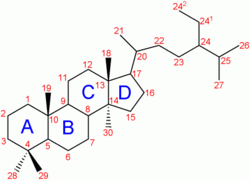Androgen

Androgen or androgenic hormone is the generic term for a class of natural or synthetic compounds, usually a steroid hormone, that stimulates or controls the development and maintenance of masculine characteristics in vertebrates by binding to androgen receptors. This includes the activity of the accessory male sex organs and development of male secondary sex characteristics. They are also called testoids.
The primary and most well-known androgen is testosterone, a steroid hormone that acts in vertebrates to regulate many sexually dimorphic traits and express many fitness related traits in males (Zysline et al. 2006). Steroid hormones such as testosterone (and estradiol on the female side) act early in development to organize male or female phenotypes that are activated later (Zysline et al. 2006). Although testosterone in vertebrates can activate male-typical phenotypes, testosterone's presence and action is not limited to males, and both sexes of most vertebrate taxa naturally produce testosterone (Zysline et al. 2006).
As hormones, androgens are secreted by cells in one part of a vertebrate (such as the testes) and travel to and coordinate the activities of cells in different parts of the body, providing a value to the whole organism. They reflect the intricate coordination and interdependence of the parts of the body.
Androgens were first discovered in 1936. Androgens are also the original anabolic steroids. They are also the precursor of all estrogens, the female sex hormones.
Overview
Androgens are any substance that influences the development and maintenance of the vertebrate male reproductive system. For example, they influence the deepening of the voice and growth of facial hair in humans and the development of the comb and wattles in chickens. (Note that women also rely on testosterone, although in smaller quantities, to maintain libido, bone density, and muscle mass throughout their lives.)
Androgens are typically steroid hormones. A steroid is any of a group of natural or synthetic, fat-soluble, organic compounds belonging to the class of lipids and characterized by a molecular core of four fused rings totaling 17 carbon atoms: Three six-carbon rings and one five-carbon ring fused together. The type of steroid is determined by the three-dimensional configuration and the type of additional side chains and rings.
Steroid hormones are steroids that act as hormones. Hormones are chemical messengers secreted by cells (including tissues and organs) in one part of a multicellular organism to travel to and coordinate the activities of different cells. An enormous range of chemicals are used for this type of cell-to-cell communication, including peptides (chains of amino acids) and steroids.
Androgens are a subset of sex hormones that also include estrogens and progestagens.
The natural steroid hormones are generally synthesized from cholesterol in the gonads and adrenal glands. In mammals, including humans, testosterone is primarily synthesized in the testes of males, but small amounts are also secreted by the female ovaries, the placenta, and the adrenal glands of both sexes.
Because these steroids are lipid soluble, they can diffuse fairly freely from the blood through the cell membrane and into the cytoplasm of target cells. In the cytoplasm, the steroid may or may not undergo an enzyme-mediated alteration such as reduction, hydroxylation, or aromatization. In the cytoplasm, the steroid binds to the specific receptor, a large metalloprotein. Upon steroid binding, many kinds of steroid receptor dimerize: Two receptor subunits join together to form one functional DNA-binding unit that can enter the cell nucleus. Once in the nucleus, the steroid-receptor ligand complex binds to specific DNA sequences and induces transcription of its target genes.
Steroid hormones are generally carried in the blood, bound to specific carrier proteins such as sex hormone binding globulin or corticosteroid binding globulin. Further conversions and catabolism occurs in the liver, other "peripheral" tissues, and in the target tissues.
Types of androgens
A subset of androgens, adrenal androgens, includes any of the 19-carbon steroids synthesized by the adrenal cortex, the outer portion of the adrenal gland (specifically, the zonula reticularis, innermost region of the adrenal cortex), that function as weak steroids or steroid precursors, including dehydroepiandrosterone (DHEA), dehydroepiandrosterone sulfate (DHEA-S), and androstenedione.
Besides testosterone, other androgens include:
- Dehydroepiandrosterone (DHEA): A steroid hormone produced in the adrenal cortex from cholesterol. It is the primary precursor of natural estrogens. DHEA is also called dehydroisoandrosterone or dehydroandrosterone.
- Androstenedione (Andro): An androgenic steroid produced by the testes, adrenal cortex, and ovaries. While androstenediones are converted metabolically to testosterone and other androgens, they are also the parent structure of estrone. Use of androstenedione as an athletic or body building supplement has been banned by the International Olympic Committee as well as other sporting organizations.
- Androstenediol: The steroid metabolite that is thought to act as the main regulator of gonadotropin secretion.
- Androsterone: A chemical by-product created during the breakdown of androgens, or derived from progesterone, that also exerts minor masculinizing effects, but with one-seventh the intensity of testosterone. It is found in approximately equal amounts in the plasma and urine of both males and females.
- Dihydrotestosterone (DHT): A metabolite of testosterone, and a more potent androgen than testosterone in that it binds more strongly to androgen receptors. It is produced in the adrenal cortex.
Androgen functions
Development of the male
Testis formation
During mammalian development, the gonads are, at first, capable of becoming either ovaries or testes (Gilbert 2000). In humans, starting at about week 4, the gonadal rudiments are present within the intermediate mesoderm adjacent to the developing kidneys. At about week 6, epithelial sex cords develop within the forming testes and incorporate the germ cells as they migrate into the gonads. In males, certain Y chromosome genes, particularly SRY, control development of the male phenotype, including conversion of the early bipotential gonad into testes. In males, the sex cords fully invade the developing gonads.
Androgen production
The mesoderm-derived epithelial cells of the sex cords in developing testes become the Sertoli cells, which will function to support sperm cell formation. A minor population of non-epithelial cells appear between the tubules by week 8 of human fetal development. These are Leydig cells. Soon after they differentiate, Leydig cells begin to produce androgens.
Androgen effects
The androgens function as paracrine hormones required by the Sertoli cells in order to support sperm production. They are also required for masculinization of the developing male fetus (including penis and scrotum formation). Under the influence of androgens, remnants of the mesonephron, the Wolffian ducts, develop into the epididymis, vas deferens, and seminal vesicles. This action of androgens is supported by a hormone from Sertoli cells, AMH, which prevents the embryonic Müllerian ducts from developing into fallopian tubes and other female reproductive tract tissues in male embryos. AMH and androgens cooperate to allow for the normal movement of testes into the scrotum.
Early regulation
Before the production of the pituitary hormone luteinizing hormone (LH) by the embryo starting at about weeks 11-12, human chorionic gonadotrophin (hCG) promotes the differentiation of Leydig cells and their production of androgens. Androgen action in target tissues often involves conversion of testosterone to 5α-dihydrotestosterone (DHT).
Spermatogenesis
During puberty, androgen, LH and follicle stimulating hormone (FSH) production increase and the sex cords hollow out, forming the seminiferous tubules, and the germ cells start to differentiate into sperm. Throughout adulthood, androgens and FSH cooperatively act on Sertoli cells in the testes to support sperm production (Nussey and Whitehead 2001).
Exogenous androgen supplements can be used as a male contraceptive. Elevated androgen levels caused by use of androgen supplements can inhibit production of LH and block production of endogenous androgens by Leydig cells. Without the locally high levels of androgens in testes due to androgen production by Leydig cells, the seminiferous tubules can degenerate resulting in infertility. For this reason, many transdermal androgen patches are applied to the scrotum.
Inhibition of fat deposition
Males typically have less adipose tissue than females. Recent results indicate that androgens inhibit the ability of some fat cells to store lipids by blocking a signal transduction pathway that normally supports adipocyte function (Singh et al. 2005).
Muscle mass
Males typically have more skeletal muscle mass than females. Androgens promote the enlargement of skeletal muscle cells and probably act in a coordinated manner to enhance muscle function by acting on several cell types in skeletal muscle tissue (Sinha-Hikim et al. 2004).
Brain
Circulating levels of androgens can influence human behavior because some neurons are sensitive to steroid hormones. Androgen levels have been implicated in the regulation of human aggression (Giammanco et al. 2005) and libido.
Insensitivity to androgen in humans
Reduced ability of an XY karyotype fetus to respond to androgens can result in one of several problems, including infertility and several forms of intersex conditions.
ReferencesISBN links support NWE through referral fees
- Gilbert, S. F. 2000. Developmental Biology, 6th ed. Sunderland, Mass: Sinauer Associates. Retrieved August 2, 2007.
- Giammanco, M., G. Tabacchi, S. Giammanco, D. Di Majo, and M. La Guardia. 2005. Testosterone and aggressiveness. Med Sci Monit. 11(4): RA136-45. Retrieved August 2, 2007.
- Nussey, S. S., and S. A. Whitehead. 2001. Endocrinology: An Integrated Approach. Oxford: BIOS Scientific Publishers, Ltd. Retrieved August 2, 2007.
- Singh, R., J. N. Artaza, W. E. Taylor, M. Braga, X. Yuan, N. F. Gonzalez-Cadavid, and S. Bhasin. 2005. Testosterone inhibits adipogenic differentiation in 3T3-L1 cells: Nuclear translocation of androgen receptor complex with {beta}-catenin and TCF4 may bypass canonical Wnt signaling to downregulate ddipogenic transcription factors. Endocrinology. Retrieved August 2, 2007.
- Sinha-Hikim, I., W. E. Taylor, N. F. Gonzalez-Cadavid, W. Zheng, and S. Bhasin. 2004. Androgen receptor in human skeletal muscle and cultured muscle satellite cells: Up-regulation by androgen treatment. The Journal of Clinical Endocrinology & Metabolism 89: 5245-5255. Retrieved August 2, 2007.
- Zysling, D. A., T. J. Greives, C. W. Breuner, J. M. Casto, G. E. Demas, and E. D. Ketterson. 2006. Behavioral and physiological responses to experimentally elevated testosterone in female dark-eyed juncos (Junco hyemalis carolinensis). Hormones and Behavior 50: 200-207. Retrieved June 23, 2007.
Credits
New World Encyclopedia writers and editors rewrote and completed the Wikipedia article in accordance with New World Encyclopedia standards. This article abides by terms of the Creative Commons CC-by-sa 3.0 License (CC-by-sa), which may be used and disseminated with proper attribution. Credit is due under the terms of this license that can reference both the New World Encyclopedia contributors and the selfless volunteer contributors of the Wikimedia Foundation. To cite this article click here for a list of acceptable citing formats.The history of earlier contributions by wikipedians is accessible to researchers here:
The history of this article since it was imported to New World Encyclopedia:
Note: Some restrictions may apply to use of individual images which are separately licensed.
